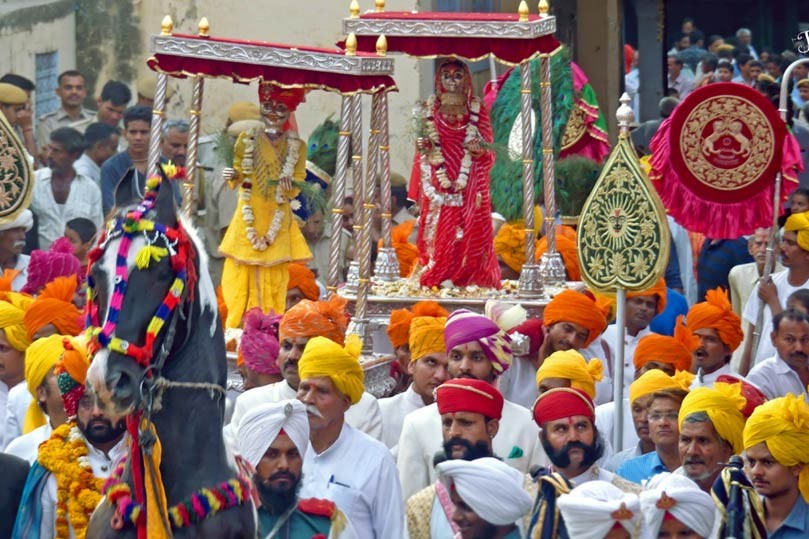The Gangaur Festival is one of the most graceful and spiritually significant festivals celebrated in the royal state of Rajasthan, as well as parts of Madhya Pradesh, Gujarat, and West Bengal. The word ‘Gangaur’ is derived from ‘Gana’, another name for Lord Shiva, and ‘Gaur’, a reference to Goddess Gauri or Parvati. The festival honors the divine union of Shiva and Parvati and symbolizes marital bliss, love, fertility, and feminine power.
In 2026, Gangaur will be celebrated from March 31 to April 16, with the most elaborate processions taking place during the final days. For women, especially in Rajasthan, this is a festival of hope, devotion, and joy. Unmarried girls pray for a suitable life partner while married women pray for their husband’s longevity and family well-being.
From the deserts of Bikaner to the lakes of Udaipur and the palaces of Jaipur, Gangaur paints Rajasthan in vivid shades of color, prayer, music, and tradition.
Rituals & Traditions of Gangaur
The Gangaur festival spans 16 days, beginning the day after Holi. During this period, women wake up early, bathe, wear new clothes, and worship clay idols of Gauri and Isar (Shiva), decorating them with flowers, vermilion, and mirrors.
- Clay Idol Worship: Women create or purchase small clay idols of Shiva and Parvati and worship them at home with daily offerings.
- Mehndi & Traditional Attire: Applying henna and dressing in ghagras and odhnis are integral parts of the celebration.
- Songs & Bhajans: Traditional Gangaur geet (songs) are sung daily, narrating mythological tales and celebrating feminine virtues.
- Fasting & Devotion: Many women observe semi-fasts, eating only once a day and focusing on spiritual connection.
These rituals are a deep expression of womanhood, family bonding, and cultural identity in Rajasthan.
The Gangaur Procession in Jaipur
One of the most visually striking events of Gangaur is the grand procession in Jaipur, organized by the Rajasthan Tourism Department. The Gangaur Mata idol is taken out in a traditional palanquin, accompanied by a parade of:
- Caparisoned elephants and camels
- Folk musicians and dancers
- Chhatris (decorated umbrellas)
- Royal guards and devotees
The procession starts from the City Palace and moves through Tripolia Bazaar and Chhoti Chaupar, attracting thousands of spectators. It’s a prime opportunity for travelers and photographers to witness Rajasthan’s devotion and artistry in motion.
Jaipur’s Gangaur celebration is especially significant due to its deep-rooted royal patronage. Historically supported by the Kachwaha Rajput rulers, the city’s traditions remain grand and culturally authentic. The old city is beautifully decorated with flowers, lights, and rangolis, and many families bring out antique idols passed down through generations. Locals sing Gangaur geet (devotional folk songs), and women can be seen dressed in traditional leheriya and bandhej sarees. Even the streets come alive with festive energy, drawing not just tourists but also researchers, documentary filmmakers, and culture enthusiasts from around the world. It is in Jaipur that Gangaur transforms from a personal ritual into a public cultural extravaganza.
Udaipur’s Royal Gangaur Boat Procession
In Udaipur, the festival takes on a serene, regal form. The idols of Isar and Gauri are carried in boats across Lake Pichola, beginning from the City Palace Ghat. Locals and tourists gather at the Gangaur Ghat, where the entire lakefront is lit with lamps, music, and devotional fervor.
The boat procession reflects Udaipur’s unique identity as the “City of Lakes”, combining royal charm with religious beauty. Women sing songs, sway diyas, and float flowers, making it a deeply soulful and visually poetic experience.
Cultural Significance & Symbolism
Gangaur isn’t just about rituals — it’s a celebration of feminine strength, love, and life cycles. It empowers women with cultural importance and provides a platform for expressing spiritual and emotional devotion.
The festival also helps preserve Rajasthan’s traditional crafts, music, and community life. From potters and idol-makers to folk performers and artisans, Gangaur sustains local economies while binding generations through shared customs.
For young girls, it’s also an initiation into the values of patience, prayer, and love.
